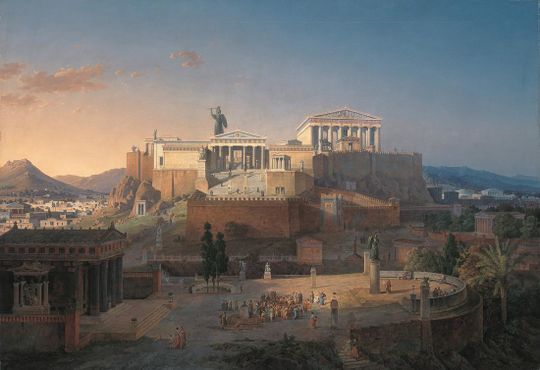Golden age of Greece

The golden age of Pericles in Athens was one of the richest eras in the history of the entire world. The construction of the Parthenon, the finest talents of art, of government and drama came forth in that period. It was a flowering of genius.
Serapis Bey was embodied as the sculptor Phidias. He was regarded as the greatest of all the Greek sculptors. His most famous work was the forty-foot high statue of Pallas Athena in gold and ivory that stood inside the Parthenon in Athens. He was also the architect of the Parthenon itself and supervised its exquisitely masterful construction. He lived as the ultimate personification of the golden age, a Grecian master artist who had an enduring influence on all subsequent Western art.
There was something very special about Greece—it was a mandala, a pattern of a golden-age society, which the masters of the Great White Brotherhood attempted to outpicture at that time. They sought to restore from ancient Lemuria and Atlantis some of the great works of art and science and the understanding of God-government.
Moderation in all things, the Greek ideal, reminds us of the Middle Way of Buddha and the Eightfold Path. The cardinal sin was pride, where an individual would assume a role that was reserved for the gods.
El Morya was instrumental in bringing forth Greek culture in that age, which came to an end in the Peloponnesian War between Athens and Sparta and the warring of the Greek city-states, vying for power, their great jealousy and envy of Athens. During the war, the karma of division descended: a plague carried away a third of the population of Athens. The rest lost the will to fight.
The purpose of the Greek city-states was to bring forth the perfect government, perfect science and art, perfect literature; and their initiation was to unite the city-states in the fiery core of the energies of Alpha and Omega, the perfect balance of Father-Mother, of the T’ai Chi. When it came time to unite, instead of going within, they rebelled, and the separation of the Greek city-states marked an initiation failed.
The sponsorship of El Morya
Beloved God Harmony has spoken of the golden age of Greece:
I would take you now in thought for a moment to the islands of Greece. And, beloved ones, I would point out to you a portion of the culture externalized there through the ministrations of that great chohan of the rays, beloved El Morya. I would point out that Greece reflected in her glory, by reason of the sculptury and statuary there, a manifestation of symmetry in form and beauty which was outpictured by the young of that nation so that they were able to develop a spirit of Olympia, the abode of the Gods, a realm of perfection, a realm of light.
And although they knew not the glory of God, having erected on Mars Hill an inscription of the unknown God, which Saint Paul commented upon as he passed by, saying, “You have erected here this temple to the unknown God. Him declare I unto you.” Then, beloved ones, I call to your attention that that civilization of Greece ignorantly worshiped the one supreme God in spite of the fact and regardless of the fact that they had a multiplicity of Gods and that it is so interpreted today by mankind, by philosophers, by theologians, and by those in the outer world.[1]
Saint Germain has also spoken of El Morya’s sponsorship of the golden age of Greece:
In ancient Greece, the beloved El Morya shed his light in the attempt to bring about a wonderful civilization where all might outpicture perfection and beauty in their bodies as well as in their minds. Today man’s consciousness has turned away from a realization of this otherworldly beauty and love, but there are many hearts that are seeking this very beauty and love.[2]
Sources
Elizabeth Clare Prophet, October 10, 1975.
Elizabeth Clare Prophet, August 10, 1979.
